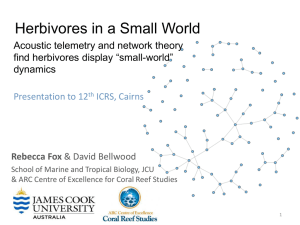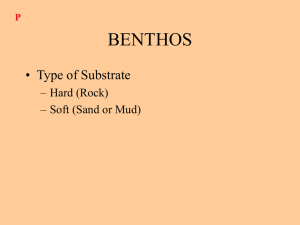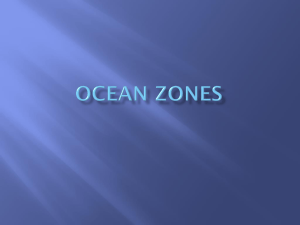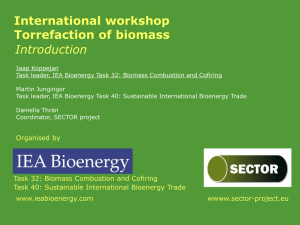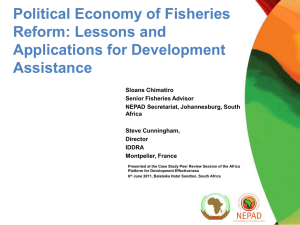1630 Edwards C
advertisement
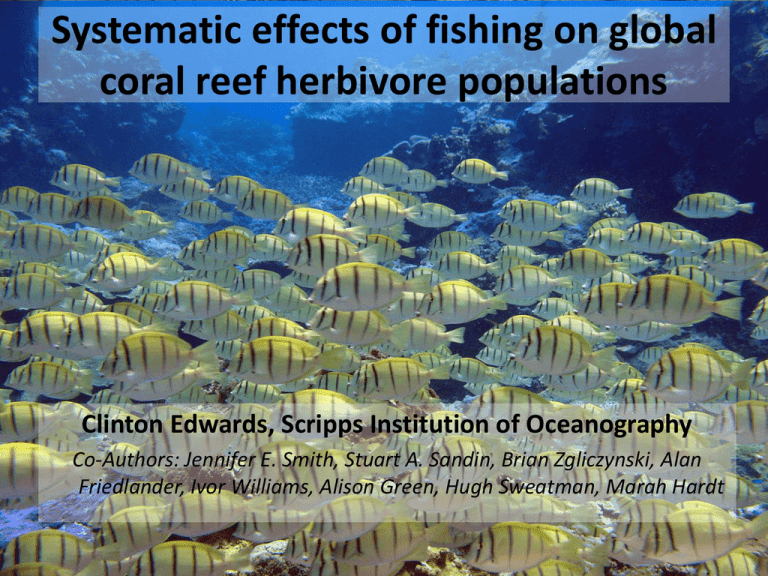
Systematic effects of fishing on global coral reef herbivore populations Clinton Edwards, Scripps Institution of Oceanography Co-Authors: Jennifer E. Smith, Stuart A. Sandin, Brian Zgliczynski, Alan Friedlander, Ivor Williams, Alison Green, Hugh Sweatman, Marah Hardt The problem… Causes of reef decline… Global Stressors: Warming Acidification Tropical Storms Pollution Coastal Development Local Stressors: Overfishing Top-down influence of herbivory Biomass g m-2 Caribbean Pacific Herbivore biomass and macroalgal cover are negatively correlated Williams (2001), Friedlander et al. (2007) Top-down influence of herbivory Experimental herbivore removal consistently leads to an increase in fleshy algae Smith et al (2010), Burkepile et al (2006) Evidence for exploitation (Protected) (Fished) Lower biomass, fewer numbers and smaller sized herbivores in fished areas Friedlander (2004) The need for research • Herbivores are important for healthy reef structure & function • But… – What is the global status of coral reef herbivorous fish populations? – Is there evidence for fishing effects? – Are different feeding guilds affected differently? Herbivore functional groups Functional subgroups are based on different feeding modes Different feeding modes result in variable impacts to the reef matrix Browsers Grazer / Detritivores Photo: Minguell, C. Scraper / Small Excavators Photo: Jen Smith Photo: Jen Smith Territorial Damselfish Photo: Rainer Kretzberg Herbivore density project Our Goals: 1. Identify natural levels of herbivore populations on pristine reefs and document variability 2. Determine evidence for fishing effects 3. Determine exploitation effects on functional groups Methods: Develop a comprehensive database of worldwide herbivore biomass/abundance levels Systematic literature review Governmental and other monitoring programs: CRED, TNC, AIMS Methods: data collection • Institute for Scientific Information (ISI) Web of Science database • 1980-2011 • Search terms= herbiv*, biomass, abundance, herbiv* and assemblage, etc. • Qualitative or quantitative description of depth, reef zone (fore reef, reef crest, etc.) and reef type (barrier reef, atoll, etc.) • Site location information and time period of study • Rigorous and peer reviewed method for evaluating fish biomass and/or abundance (SPC or belt) • Report abundance and/or biomass means of all major herbivorous fishes found in the study area • Fisheries accessibility • Unpublished monitoring datasets were subject to the same criteria Methods: fisheries accessibility • Fisheries accessibility was designated based upon human habitation, isolation and level of protection at each site where surveys were conducted • Two levels of fishing activity • “not fisheries accessible” (NFA) • “fisheries accessible” (FA) Methods: analysis (i) Global means of biomass and abundance for NFA and FA areas (ii) Differences between NFA and FA locations within regions (iii) Functional group analysis Results: data collection • 300+ studies from search criteria • Only 75 studies meet full criteria • Unpublished datasets from Indonesia, Pacific Islands, Caribbean, Hawaii, GBR & Indian Ocean • 2706 site level estimates of biomass and abundance from 145 locations Results: overall biomass & abundance Not Fisheries Accessible (NFA) Fisheries Accessible (FA) NFA FA NFA FA Results: regional effects of fishing Results: world-wide island level herbivore biomass Results: functional group biomass Conclusions • Over-exploitation of fish resources has large impacts on herbivorous fish assemblages • Fisheries accessibility changes the size structure of the herbivores guild; fished reefs are dominated by relatively abundant and smaller individuals • Herbivore biomass has declined in most regions; biomass levels as high as >100g m-2 are found on many unfished reefs • Fisheries accessible reefs have altered functional group structure • Management schemes should take into consideration natural levels of the different functional groups of herbivores Conclusions • Over-exploitation of fish resources has large impacts on herbivorous fish assemblages • Fisheries accessibility changes the size structure of the herbivores guild; fished reefs are dominated by relatively abundant and smaller individuals • Herbivore biomass has declined in most regions; biomass levels as high as >100g m-2 are found on many unfished reefs • Fisheries accessible reefs have altered functional group structure • Management schemes should take into consideration natural levels of the different functional groups of herbivores Conclusions • Over-exploitation of fish resources has large impacts on herbivorous fish assemblages • Fisheries accessibility changes the size structure of the herbivores guild; fished reefs are dominated by relatively abundant and smaller individuals • Herbivore biomass has declined in most regions; biomass levels as high as >100g m-2 are found on many unfished reefs • Fisheries accessible reefs have altered functional group structure • Management schemes should take into consideration natural levels of the different functional groups of herbivores. Conclusions • Over-exploitation of fish resources has large impacts on herbivorous fish assemblages • Fisheries accessibility changes the size structure of the herbivores guild; fished reefs are dominated by relatively abundant and smaller individuals • Herbivore biomass has declined in most regions; biomass levels as high as >100g m-2 are found on many unfished reefs • Fisheries accessible reefs have altered functional group structure • Management schemes should take into consideration natural levels of the different functional groups of herbivores Conclusions • Over-exploitation of fish resources has large impacts on herbivorous fish assemblages • Fisheries accessibility changes the size structure of the herbivores guild; fished reefs are dominated by relatively abundant and smaller individuals • Herbivore biomass has declined in most regions; biomass levels as high as >100g m-2 are found on many unfished reefs • Fisheries accessible reefs have altered functional group structure • Management schemes should take into consideration natural levels of the different functional groups of herbivores Thank You!! Collaborators & Contributors: Jennifer Smith Stuart Sandin Alan Friedlander Ivor Williams Alisson Green Brian Zgliczynski Marah Hardt Hugh Sweatman Australian Institute of Marine Science (AIMS) NOAA Coral Reef Ecosystem Division (CRED) The Nature Conservancy (TNC) CAMEO (funding); NSF & NOAA Thank you also…. Levi Lewis, Emily Kelly, Nichole Price Andrew Lukosus The entire Smith-Sandin academic-industrial-complex!!! Come see us!!! For more information about this work and the other fascinating topics of research being conducted by myself and my colleagues please visit the Coral Reef Systems booth (I will be there from 8-10 Tue/Thurs)


